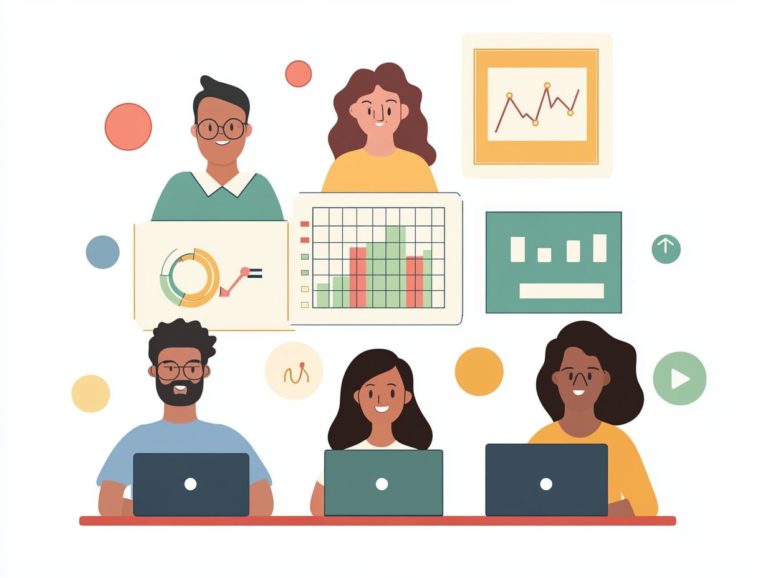E-Learning Solutions for Global Teams: Challenges
In today s interconnected world, e-learning is essential for global teams to enhance their skills and collaborate effectively.
Implementing these solutions presents challenges. Cultural and language barriers, technology limitations, and time zone differences can complicate training logistics.
The benefits are clear. E-learning increases accessibility and saves costs, making it worthwhile and essential.
Let s explore the hurdles and advantages of e-learning for global teams. We ll offer strategies to navigate these challenges for a smoother, more effective learning experience.
Contents
- Key Takeaways:
- Challenges of Implementing E-Learning Solutions for Global Teams
- Benefits of E-Learning for Global Teams
- Strategies for Overcoming E-Learning Challenges
- Frequently Asked Questions
- What are some common challenges faced by global teams when using e-learning solutions?
- What strategies can break down language barriers in global e-learning?
- What can be done to overcome time zone differences in e-learning for global teams?
- How do cultural differences impact e-learning for global teams?
- What can be done to address technical difficulties in e-learning for global teams?
- How can e-learning solutions for global teams encourage interaction and collaboration?
Key Takeaways:

- E-learning solutions face challenges like cultural barriers, technology limitations, and time zone differences.
- It offers flexibility, cost savings, and improved collaboration.
- Effective communication, using technology, and fostering a supportive environment can help overcome these challenges.
Defining E-Learning and Global Teams
E-learning, especially when training global teams, provides a strong framework for virtual education through online learning platforms and standardized training methods. This innovative approach boosts employee development and corporate education by delivering tailored learning experiences for diverse skill levels across geographical borders.
With a Learning Management System (LMS), which is software that helps deliver and track training online, you can provide engaging content that effectively addresses skills gaps and fosters knowledge retention. Immersive training includes virtual sessions and instructor-led classes, ensuring compliance while helping more people finish their training.
E-learning is vital for corporate success today! It offers a level of flexibility that traditional training methods often struggle to match. By incorporating multimedia resources, like videos and interactive modules, you can capture your employees’ attention more effectively. This adaptability allows learners to engage at their own pace, accommodating various learning styles.
Analytics from LMS platforms help you monitor progress and pinpoint areas needing improvement, ensuring that your training aligns seamlessly with organizational goals. E-learning fosters a culture of continuous learning, which is essential for keeping your teams competitive in today s fast-paced business landscape.
Challenges of Implementing E-Learning Solutions for Global Teams
Implementing e-learning solutions for global teams comes with challenges that require careful navigation. Understanding the challenges of e-learning in corporate settings is essential to ensure effective training compliance and engagement across diverse regions.
These challenges include cultural and language barriers, technological limitations, and the complexities of time zone differences, which can lead to scheduling difficulties for training.
Understanding the unique needs of a global workforce is essential to effectively address skills gaps and cultivate a culture of continuous learning.
Cultural and Language Barriers
Cultural and language barriers pose significant challenges in the effective implementation of eLearning solutions within a global workforce. These disparities can lead to misunderstandings and complicate the training compliance process.
It s essential for organizations to recognize the diverse backgrounds of their employees and develop tailored learning strategies that accommodate various cultural contexts and language proficiencies. This approach not only enhances development but also cultivates an inclusive learning environment that promotes knowledge retention and engagement.
For instance, companies can incorporate localized content that resonates with the beliefs and practices of different cultural groups, making the learning experience more relatable. Providing materials in multiple languages or utilizing visual aids can help bridge language gaps, increasing comprehension and participation.
Integrating examples and case studies that reflect the cultural nuances of a region can deepen engagement. By being attuned to these differences, organizations can create a supportive atmosphere where individuals feel valued and enabled to thrive in their learning journey.
Technological Limitations
Technological limitations can hold you back from successful eLearning, creating challenges that need to be overcome for effective training delivery and learner engagement. Issues like inadequate internet connectivity, lack of access to user-friendly technology, and reliance on outdated Learning Management Systems can lead to frustrating experiences for both learners and instructors.
To truly maximize the potential of virtual sessions and online training programs, it’s crucial to invest in strong technology support and systems that facilitate seamless eLearning experiences.
This includes providing access to high-speed internet and equipping your team with devices that support modern software applications. For example, adopting platforms like Moodle or Canvas can greatly enhance user experience by offering intuitive interfaces and customizable features that cater to various learning styles.
Consider implementing mobile-friendly solutions as well, allowing learners to access training materials on-the-go. By fostering a more adaptable and user-centric approach to technology, you can significantly boost learner satisfaction and engagement, transforming potential obstacles into opportunities for growth and development.
Time Zone Differences

Time zone differences can pose a significant challenge when training global teams, leading to scheduling headaches that disrupt the effectiveness of your virtual sessions and eLearning initiatives. Coordinating training logistics across multiple regions requires a strategic approach to accommodate various time zones and maximize participation.
By utilizing real-time analytics and feedback mechanisms, you can pinpoint optimal training windows and keep your global workforce engaged throughout the learning process. To further enhance the effectiveness of your eLearning, consider the unique needs of team members in different regions.
This might mean creating a flexible schedule with varied time slots or using asynchronous learning materials that employees can access whenever it suits them. Embracing technology platforms that automatically adjust for time zone differences can greatly streamline the scheduling process.
By analyzing participation patterns and engagement metrics, you can refine your training strategies, ensuring that every individual, no matter where they are, fully benefits from the learning experience.
Benefits of E-Learning for Global Teams
The benefits of e-learning: bridging knowledge gaps in corporations for global teams are extensive, providing the flexibility and accessibility essential for contemporary corporate education and employee development.
By utilizing online learning platforms, organizations can deliver comprehensive training programs tailored to varying skill levels across different geographical regions. eLearning can also lead to significant cost savings by reducing travel expenses and facilitating scalable training solutions that enhance overall effectiveness and boost learner engagement.
Increased Flexibility and Accessibility
One of the biggest advantages of eLearning is the increased flexibility and accessibility it offers, especially for global teams. You can engage in online learning at your own pace and on your own schedule.
This hybrid approach is particularly useful in corporate education. It accommodates your diverse learning styles and preferences while allowing you to balance your professional responsibilities with training commitments.
As a result, your organization can cultivate a culture of continuous learning and development, enhancing both your satisfaction and retention.
By implementing tools like self-paced learning modules, video tutorials, and live virtual workshops, companies can cater to the varying schedules and time zones of their workforce. For example, a multinational organization might provide a mix of on-demand courses and scheduled live sessions, allowing you and your colleagues from different regions to participate without the hassle of conflicting work hours.
Incorporating gamification elements and interactive features can make learning even more enticing, transforming it into an engaging and enjoyable experience. These strategies boost knowledge retention and foster a sense of community among team members, reinforcing collaboration across geographical boundaries.
Cost Savings
Implementing eLearning solutions can save your organization a lot of money, especially in the realm of corporate education and employee development. By moving your training programs to online platforms, you can dramatically cut down on travel expenses associated with traditional instructor-led sessions and streamline training logistics.
This newfound savings can be reinvested into upgrading your training materials and incorporating user-friendly technology, ultimately enhancing the overall educational experience.
Imagine saving money by eliminating physical meeting spaces. You can redirect funds typically allocated for venue rentals into creating high-quality video content or interactive modules that captivate your learners.
You can also leverage analytics from eLearning platforms to pinpoint which training programs deliver the best results. This allows you to focus on the most effective learning strategies.
This data-driven approach conserves your financial resources and cultivates a culture of continuous improvement, progressively enhancing workforce skills with every iteration of your training.
Improved Collaboration and Communication
E-learning enhances collaboration and communication among your global teams by providing a dynamic platform for real-time interaction and shared learning experiences. Utilizing virtual sessions, webinars, and collaborative tools, you can connect with employees across diverse regions.
This approach bridges geographical divides and nurtures essential knowledge sharing and teamwork two cornerstones of a successful global workforce.
Consider using tools like Slack and Microsoft Teams, which streamline communication and allow effortless collaboration through dedicated channels for specific projects. Meanwhile, platforms such as Zoom and Google Meet facilitate face-to-face connections, promoting engagement even when team members are continents apart.
Collaborative documents on Google Drive can be updated in real-time, ensuring everyone has access to the latest information. This significantly boosts productivity and deepens the community feel among team members.
Strategies for Overcoming E-Learning Challenges

To effectively navigate the challenges of e-learning solutions for global teams, you must implement strategic measures that tackle potential obstacles while enhancing training engagement. This involves adopting strong communication practices and leveraging advanced technology to foster a supportive and inclusive learning environment.
By prioritizing these strategies, you can promote learner engagement, facilitate knowledge retention, and ensure that training objectives are successfully met across your diverse teams.
Addressing these challenges is crucial for successful eLearning, creating an environment where continuous improvement thrives.
Effective Communication and Training Techniques
Employing effective communication and training techniques is essential for optimizing employee development and ensuring learner engagement in eLearning environments. You can implement various feedback mechanisms and assessment tools to gauge understanding and adjust your training approaches accordingly.
This proactive strategy cultivates a culture of continuous learning and enhances the overall effectiveness of your training programs, addressing any skills gaps that may emerge.
For instance, using interactive quizzes and real-time polling during training sessions provides immediate insights into participant comprehension. Incorporating peer review systems fosters collaborative learning, allowing employees to offer feedback to one another, thereby reinforcing their understanding.
Virtual breakout rooms can simulate group discussions, promoting deeper engagement. Such adaptive methods reflect the dynamic nature of eLearning, ensuring that employee development remains both responsive and effective.
Utilizing Technology and Virtual Tools
Effectively utilizing technology and virtual tools can significantly elevate the quality and delivery of your eLearning solutions for global teams, maximizing accessibility and learner engagement. A robust learning platform enables the deployment of interactive technologies that foster collaboration and knowledge sharing. By integrating these tools into your training programs, you can create immersive learning experiences tailored to diverse skill levels and learning preferences.
This approach builds community among participants, enabling them to take charge of their own learning journeys. With features like game-like features, virtual simulations, and real-time feedback, these systems transform traditional training into dynamic experiences.
Consider leveraging data analytics to track engagement and performance, allowing for continuous improvement and personalized learning paths. By embracing these advancements, you can ensure that your training initiatives are not just effective but also enjoyable, resulting in higher retention rates and better overall outcomes.
Creating a Supportive and Inclusive Learning Environment
Creating a supportive and inclusive learning environment is essential for ensuring training compliance and boosting employee satisfaction across your global teams. You should prioritize the development of training programs that respect cultural differences, fostering an atmosphere where open dialogue, collaboration, and knowledge sharing thrive. A supportive environment supercharges learning and drives engagement!
Integrating various learning styles and cultural perspectives ensures everyone feels valued and understood, ultimately contributing to a more cohesive team dynamic. Consider strategies such as incorporating diverse case studies, offering multilingual resources, and actively seeking feedback from employees to significantly enhance the training experience.
Don t miss the chance to create an open communication policy where team members feel comfortable sharing their thoughts and experiences. This two-way conversation not only allows for real-time improvements in training materials but also helps cultivate a sense of belonging, leading to higher productivity and morale within your global team.
Frequently Asked Questions
Here are some common questions about e-learning solutions for global teams.
What are some common challenges faced by global teams when using e-learning solutions?

- Language barriers
- Time zone differences
- Cultural differences
- Technical difficulties
- Lack of face-to-face interaction
What strategies can break down language barriers in global e-learning?
E-learning platforms can offer translation options, provide multilingual resources, and allow for communication in various languages. It is also helpful for team members to have a basic understanding of the common language used within the team.
What can be done to overcome time zone differences in e-learning for global teams?
Struggling with time zone differences in your e-learning? Here s how you can tackle it effectively! Create a flexible schedule that works across time zones. Also, provide recordings of live sessions for team members to access anytime.
How do cultural differences impact e-learning for global teams?
Cultural differences shape how people learn and communicate. E-learning solutions must be inclusive, and team members should respect diverse perspectives.
What can be done to address technical difficulties in e-learning for global teams?
E-learning platforms need to be user-friendly and offer help for tech problems. Team members must have reliable internet and equipment for the best learning experience.
How can e-learning solutions for global teams encourage interaction and collaboration?
Incorporate interactive features like discussion boards and group projects in e-learning platforms. Team leaders should promote regular communication and team-building activities.






